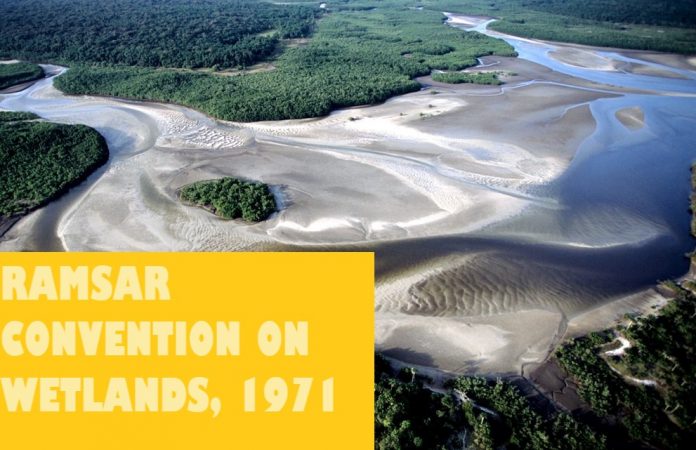This article has been written by Nishtha Jain, a fourth-year student from Symbiosis Law School, Noida. She has discussed the Ramsar Convention; highlighting the poor implementation and inefficient laws in India.
What are wetlands and why do we need to conserve them?
Popularly known as nature’s kidneys that purify the environment, wetlands are a vital part of the hydrological cycle. Wetlands not only support large biological diversity but also provide a wide range of ecosystem services such as soil erosion control, flood mitigation, agriculture, water purification, water assimilation, groundwater recharge and much more.
Most importantly, wetlands play a major role as a source of freshwater and encompass diverse assemblage of habitats. They are home for a variety of creatures including birds and serves as temporary homes for migratory birds. They perform manifold functions in the maintenance of the ecological balance. However, these fragile ecosystems are susceptible to damage and are getting exploited by the humans’ ever-growing greed and hence, are in grave danger of extinction.
What is the Ramsar Convention?
Recognizing the importance of protecting such water bodies, the Government of India became a Contracting Party to the only international treaty primarily focused on protecting Wetlands – “Ramsar Convention – The Convention on Wetlands of International Importance especially as Waterfowl Habitat” adopted on 2nd February 1971 and came into force in 1975.
The Ramsar Convention (popularly known as Wetlands Convention) defines wetlands in a very broad sense. According to the Convention, wetlands are “areas of marsh, fen, peatland or water, whether natural or artificial, permanent or temporary, with water that is static or flowing, fresh, brackish or salt, including areas of marine water the depth of which at low tide does not exceed six meters”. In simple words, wetlands include areas of marsh, fen, peatland or water. They may be natural or artificial. They may be permanent or temporary. The water in wetlands may be static or flowing, fresh, brackish or salt.
The basic tenets of the treaty text have been developed and interpreted by the Conference of the Contracting Parties. The developments and changes are made taking into consideration the environmental impact that those changes/developments would bring forth.
What are the bodies of the Convention?
To date, 170 countries have joined as Contracting Parties and are encouraged to maintain the ecological character of all wetlands. Some of the nations along with India are – Cambodia, Ghana, Egypt, Italy, Kenya, New Zealand, Sri Lanka, etc.
The Contracting Parties have three primary obligations –
- Wisely using and conserving all wetlands in their respective countries.
- Designating and conserving at least one Ramsar Site i.e. wetland of international importance.
- Cooperating across national boundaries on transboundary wetlands.
Member Countries are required to report any adverse human-induced changes in a Ramsar site and take necessary actions to restore these wetlands to their former state. Ramsar sites, which are of international importance, are those which have been listed in the Ramsar List uploaded on Ramsar Convention’s official website. However, this doesn’t mean that the sites which are not included in the list are not to be protected and conserved.
The Contracting Parties are required to implement the Wetland Convention properly in their territories as well as collaborate and efficiently contribute to shared projects. The government agency responsible for the national application of the Wetland Convention is known as the country’s Administrative Authority.
Every three years, the Contracting Parties meet at the “Conference of the Contracting Parties” (COCP). After thorough discussions, they adopt decisions to administer the Convention. Further, they guide the implementation of the Convention as well. A Standing Committee is appointed by the Conference of Contracting Parties under whose authority day-to-day administration is entrusted to a Secretariat.
The Scientific and Technical Review Panel (the STRP) and the Communication, Education, Participation and Awareness (CEPA) Oversight Panel are two advisory bodies that provide technical guidance to the Standing Committee. Official partners of the Convention are – Convention’s Secretariat and the International Organization Partners (IOPs), who provide support in various forms to the Contracting Parties.
A Strategic Plan if formulated and the scope and focus of the Convention’s work is coordinated by this Strategic Plan itself. This Plan lists out the objectives and action plans that are to be followed or expected to be followed by the bodies of the Ramsar Convention. Started to protect and provide habitat for waterfowl habitat, it has now expanded its goals and succeeded in keeping the work of the Convention abreast of changing world perceptions, priorities, and trends in environmental thinking inclusive of sustainable urban future.
What is the mission of the Ramsar Convention?
As adopted in 1999 and refined in 2002, the mission of Convention is clearly opined as, “the conservation and wise use of all wetlands through local, regional and national actions and international cooperation, as a contribution towards achieving sustainable development throughout the world”. The term “wise use” is at the heart of the Convention and is defined as “the maintenance of (a wetland’s) ecological character, achieved through the implementation of ecosystem approaches, within the context of sustainable development”.
Is the Ramsar Convention being properly implemented in India?
Ever since the commencement of this Convention, countries around the globe have initiated numerous conservation efforts. However, at least in the case of India, it would be accurate to say that not much has been done to protect the wetlands and such issues have received little attention by the decision makers in the country.
There are several underlying reasons for this lack of effort by the concerned Government agencies to review the legal systems concerning the wise use of wetlands. Many factors are involved in this ranging from a vast number of users and economic interests attached to lack of resources and ambivalent political interests of leaders as well as the varying geographical characteristics of wetlands and inefficiency in the proper implementation of the laws formulated and the problem of overriding jurisdictions of various legal institutions.
One of the reasons of improper implementation is the various legal institutions working over the same subject matter making it difficult to ascertain the jurisdiction and limits. Govt. of India initiated the National Wetland Conservation Programme (NWCP) in collaboration with concerned State Governments to lay down policy guidelines, monitor implementation and prepare an inventory of Indian wetlands. Ministry of Environment and Forests, Government of India (MoEF) established Salim Ali Centre for Ornithology and Natural History (SACON). The object of SACON is to establish and develop a Centre of Excellence to assist, institute, conduct and promote scientific research of various species in ornithology including their habitats and ecosystems. Their object also includes developing scientific solutions to conservation problems keeping in mind the socio-economic realities and aspirations of the people.
What are the recent developments in the law?
In the past decade, there has been considerable thinking on the need to look at the legal and institutional aspects of wetland management in the country. The Supreme Court of India is still hearing a matter M.K. Balakrishana & Ors. Vs. Union of India & Ors. (M.K. Balakrishana & Ors. v. Union of India & Ors., (2001) Writ Petition (Civil) No. 230 of 2001, the High Court of Delhi) in which there have been several orders of consequence.
Complying with one of these orders Ministry of Environment, Forest and Climate Change notified the new Wetland (Conservation and Management) Rules 2017 on 26th September 2017 replacing the 2010 version. Draft of Wetland Rules first presented in 2016 was highly criticized by the conversationalists and scholars.
What are the flaws in the Wetland (Conservation and Management) Rules, 2017?
Experts felt that the new rules have seriously weakened the existing regulations. They pointed out the following flaws –
- Rules fail to mention a national regulator and do not list activities prohibited in Wetlands and surrounding areas.
- Rules are vague and can be misused for example, “Central government may consider proposals from the state government or union territory administration for omitting any of the (prohibited) activities on the recommendation of the authority”.
- CWRA is to be replaced by a national committee and that too with only advisory role making the whole procedure of appealing against the authorities objectionable.
- Rules are silent on the appeal process as in 2010 Rules allowed for an appeal to the National Green Tribunal if aggrieved by the Central Wetland Regulatory Authority’s decision but the same is not provided in new rules.
- There are numerous loopholes as the Rules fail to mention details. For instance, a very subjective definition of “wise use” is given in the 2017 Rules and the interpretation of the same is left up to the State Government. No authority to issue directions has been prescribed which are binding in nature to desist from any activity detrimental to wetland conservation.
- Definition of wetlands as provided in 2017 Rules is highly ambiguous and hasn’t been clearly explained. Many important types of wetlands are now excluded from the definition.
- The new Rules have done away with the six points listed in the 2010 Rules describing protected wetlands, and instead, state that wetlands are limited to and do not include wetlands under forest and coastal regulation zones.
- Reclamation isn’t included as one of the restrictions on the activities which is highly disturbing. Also, the Rules provide no timelines whatsoever for phasing out solid and untreated waste from being dumped into Wetlands defeating the very purpose of formulation of the Rules.
What is the judicial attitude?
There are some more recent decisions taken by the Judiciary and Government alike which shows that all hope is not lost. Some of them are –
- In March 2018, in the matter of Radhey Mohan Misra v. State of Uttar Pradesh & Ors., the State submitted a report of identified wetlands and tribunal directed MoEF to take further action on the same as per the provisions of Rule 7 of Wetland (Conservation and Management) Rules, 2017. (Radhey Mohan Misra v. State of Uttar Pradesh & Ors , M.A. No. 657 of 2016)
- The National Green Tribunal in May 2017 reprimanded the Delhi Government over the poor condition of Purana Quila Lake and directed them to restore the lake and ensure that lake doesn’t become a waste-dumping yard.
- In September 2018, India launched a five-year plan to conserve its wetlands as part of the National Action Plan for Conservation of Migratory Birds and their Habitats (2018-2023). It is a multi-state action plan formulated for safeguarding and boosting the population of migratory birds. The plan is structured in six interrelated components and is to be reviewed every three years. If followed through properly, this plan will be able to restore at least some of India’s wetlands crucial for both humans and wildlife.
- In September 2018, National Green Tribunal on its own Motion v. Govt. of NCT of Delhi & Ors. directed an oversight committee headed by former high court judge to monitor the issue of restoration and revival of wetlands in Dwarka as it is necessary for recharge of groundwater.
- The National Green Tribunal on 6th December 2018 fined the state of Karnataka INR 50 Cr. and the Bruhat Bengaluru Mahanagara Palike, the city corporation, taking issue with the state’s “negligence” in protecting the lakes of Bengaluru. The NGT also asked the government to deposit INR 500 Cr. in an escrow account. This amount would be used for the execution of an action plan specifically focussing on the rejuvenation of the lakes. It has ordered the setting up of a committee which will be headed by Mr Santosh Hegde, former Supreme Court judge. This committee will be required to oversee the implementation of the orders of the National Green Tribunal.
What are the problems?
- Improper implementation, unnecessarily prolonging of compliance with the Rules and numerous loopholes in the existing legislation
It cannot be denied that the Government and Judiciary of India aren’t taking any steps to conserve the Wetlands of the country but at the same time the fact of improper implementation, unnecessarily prolonging of compliance with the Rules and numerous loopholes present to benefit the industrialists cannot be ignored. One such instance is of the building of a five-star Hotel in Udaisagar Lake in Rajasthan wherein Supreme Court quashed the PIL filed by an NGO to protect the water body on very frivolous grounds. Wetlands are disappearing at an alarming rate and this is the time to take affirmative action otherwise wetlands will get extinct.
- No uniform wetland policy and no Central legislation
The jurisprudence in India reveals that public interest litigations play an active and major role in the management and conservation of wetlands. India should come out of the shell and propose a uniform wetland policy all over the country and a central legislation is necessary to support this policy.
- Inefficient and ambiguous rules
The Wetland (Conservation and Management) Rules, 2017 are inefficient and ambiguous which needs to be amended and formulated taking into consideration the recommendations made by the experts.
Conclusion
The wetland protection and development needs are two different sides of the same coin. However, neither can be neglected as both of these are important for the sustainable development of India. There is a lack of strong legislative framework in India which needs to be closely examined.
The long-standing environmental problems are the growing demand for and pressure on natural resources by an ever-increasing population thus we need to get done away with loosely worded laws and start making wise decisions for prevention and conservation of the wetlands of the country.
 Serato DJ Crack 2025Serato DJ PRO Crack
Serato DJ Crack 2025Serato DJ PRO Crack











 Allow notifications
Allow notifications



